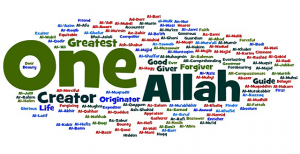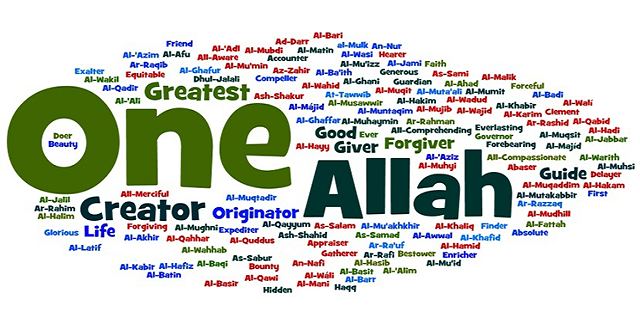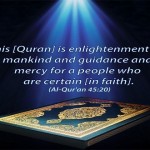What are the meanings of the informative attributes of Allah?
 Khabariyah or informative attributes, the definitions and the views expressed concerning them are some of the most contentious issues among various Islamic theological schools. Khabariyah or informative attributes refer to attributes which have been mentioned in the Quran and narrations and that they are not supported by any proofs other than textual evidence.[1] Some examples of the Quranic verses which refer to these attributes are the following:
Khabariyah or informative attributes, the definitions and the views expressed concerning them are some of the most contentious issues among various Islamic theological schools. Khabariyah or informative attributes refer to attributes which have been mentioned in the Quran and narrations and that they are not supported by any proofs other than textual evidence.[1] Some examples of the Quranic verses which refer to these attributes are the following:
1. Hand of Allah (Yadullah):
«إِنَّ الَّذِینَ یُبایِعُونَکَ إِنَّما یُبایِعُونَ اللَّهَ یَدُ اللَّهِ فَوْقَ أَیْدِیهِمْ»[2]
“Surely those who swear allegiance to you do but swear allegiance to Allah; the hand of Allah is above their hands.”
2. Face of Allah (Wajhullah):
«وَ لِلَّهِ الْمَشْرِقُ وَ الْمَغْرِبُ فَأَیْنَما تُوَلُّوا فَثَمَّ وَجْهُ اللَّهِ»[3]
“Unto Allah belong the East and the West, and whithersoever ye turn, there is Allah’s Countenance (face). Lo! Allah is All-Embracing, All-Knowing.”
3. Eye of Allah (Ainullah):
«وَ اصْنَعِ الْفُلْکَ بِأَعْیُنِنا وَ وَحْیِنا»[4]
“And make the ark before Our eyes and (according to) Our revelation, and do not speak to Me in respect of those who are unjust.”
4. Being Established on the Throne:
«الرَّحْمنُ عَلَى الْعَرْشِ اسْتَوى»[5]
“(Allah) Most Gracious is firmly established on the throne (of authority).”
Keeping in view that these verses signify that God, the Glorified is physical and corporeal, it has been agreed by all Muslim scholars that while ascribing such attributes to God, we must suffice to what has been mentioned in the Quran and reliable traditions. However, different Muslim sects have fallen into dispute concerning the interpretation and meaning of these attributes. Some have likened God to material entities and human beings in the sense that He has eyes and hands like human beings. Some others have denied these attributes with regard to Allah saying that there is no resemblance between God and human beings. However, Shiite theologians relying on traditions and sayings of the Household of the Holy Prophet (S), have their own viewpoint as shall be mentioned.
A) Shia Perspective
The Shia school following the Household (Ahlul-Bayt), peace be upon them, believe that God, the Glorified, is free from matter and that He cannot be likened to anything on the surface of the earth. A careful look at the Quranic verses and the likes will reveal their true purport to us. For instance, Shia scholars unanimously state that the word “yad” (hand) in the Quran refers to God’s power. Thus it means that God is Almighty and All-Powerful. What is meant by ‘wajh’ is God, the Almighty Himself. That is to say, everything is mortal except God. As for being establishing on throne, it also means that God is All-Knowing and All-Powerful in contriving and running the world. Not only should we believe in the denial and likeness and resemblance of Allah to any other things, rather the principle that God is purified of all likeness applies to all divine attributes. For instance, God’s knowledge cannot be considered as acquired and external to His essence. God’s knowledge is identical with His essence. It is by presence and infinite. The position is the same with God’s power and life which are infinite and identical with His very essence.
Imam Reza (A.S) has been reported as having said: “In the subject of tawhid (divine unity), people are of three tendencies: “Negation (of the attributes); likening (God’s attributes to physical attributes) and substantiation of the attributes without likening. It is not permissible to deny the attributes nor is it permissible to liken them. And what is the right path and the correct method, is the establishment of the attributes without likening.”[6] That is to say we should believe in these attributes in such a way that we do not end up likening them to physical attributes.
B) The Sefatiyah Viewpoint
Sefatiyah had been one of the theological sects with many sub-divisions including Ash’arites, Mushabbeha and Karamiyah[7]. They did not differentiate between the attributes of essence and the attributes of action. At least, some of them considered certain khabariyah (informative) attributes like “face”, and “yad” (face and hand) as proven for God without any esoteric or anagogical interpretation. They went as far as to liken divine attributes to those of humans.[8]
C) The Mu’attilah Perspective
Contrary to Sefatiyah sect, the Mu’tazilites were the ones who have denied some of the names and attributes of God and it was for the same reason that they were called “mu’attilah”[9]. In the beliefs, the resemblance between God and His creatures has been negated with regards to Allah the Glorious and Majestic. No one from the creation is similar to Him.[10] This was a short account on the existing viewpoints regarding the attributes of Allah especially the informative ones under question.
[1] Subhani, Ja’far, Simai Aqaed Shia, translated by Muhaddethi, Jawad, p. 66, Mash’ar Publications, Tehran, 1386 A.H.
[2] Fath (48): 10
[3] Al-Baqarah (2): 115
[4] Hud (11): 37
[5] Ta-ha (20): 5
[6] The Arabic version of the narration is as such:
«للناس فی التوحید ثلاثة مذاهب: نفی، و تشبیه، و اثبات بغیر تشبیه، فمذهب النفی لا یجوز، و مذهب التشبیه لا یجوز، و السبیل فی الطریقة الثالثة، اثبات بلا تشبیه»
Sheikh Saduq, al-Tawhid, researched and corrected by Hussein, Hashem, p. 101, Islamic Publications Office, Qom, first edition, 1398 A.H.
[7] Mashkoor, Muhammad Jawad, Glossary of Islamic Sects, p. 301, Astaan Quds Razawi, Mashad, second edition, 1372.
[8] Shahristani, Al-Melal wa al-Nehal, researched by Badran, Muhammad, vol.1, p. 105, Al-Sharif al-Razi, qom, 1364.
[9] Rizwani, Ali Asghar, Shiatology and Answer to Spurious Questions, vol.2, p. 513, Nashr Mash’ar Publication, Tehran, 1384.
[10] Ibn Attiyah, Jamil Hamood, Abha al-Murad, fi Sharh Mu’atmar Ulama Baghdad, vol.2, p. 152, Al-A’alami Institute, Beirut, 1423.



